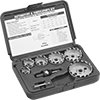Filter by
System of Measurement
For Use On
DFARS Specialty Metals
Shape
Fastener Head Type
Head Diameter
Character Type
End Shape
Shank Length
For Maximum Surface Hardness
Stamp Material
Fabricating and Machining
Measuring and Inspecting
Fastening and Joining
Electrical
Communication
Material Handling
Power Transmission
Facility and Grounds Maintenance
Building and Machinery Hardware







































































